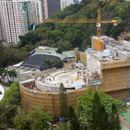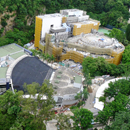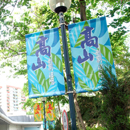 Ko Shan TheatreLeisure and Cultural Services Department
Ko Shan TheatreLeisure and Cultural Services Department
About Us
The Ko Shan Theatre was first opened in 1983 and designed as a 3,000-seat semi-open air theatre. Because of the semi-open design, the former venue suffered from inclement weather and noise problems. After an improvement project approved in 1994, the refurbished Ko Shan Theatre was re-opened in October 1996.
The former amphitheatre was demolished and rebuilt with an air-conditioned foyer block housing rehearsal facilities, committee room, exhibition facilities and URBTIX box office. The renovation aimed at providing better facilities for a wide range of public and private activities, which can intermix for the benefit of the community.
Architectural Concept
In response to the sculptural form of the former theatre, various functions within the new Theatre are organized around a flexible and free-flowing promenade. An oval-shaped foyer and a staircase are created in the centre of the promenade to act as an exhibition hall and to connect spatially with the first floor lobby. As visitors stroll along the promenade, or ascend and descend the oval-shaped staircase, multi-layered views are continuously unfolded. Moreover, external greeneries within Ko Shan Road Park are also brought into the promenade. This informal layout, free flowing and eventful passage not only improve the general circulation, but also produce an exciting, festive and lively mood in the new Theatre.
In addition, planned in co-ordination with the former theatre site context, the exterior of new Theatre is meticulously proportioned to blend in with the existing building form and the surrounding greeneries. Approaching from Ko Shan Road, visitors see a monumental portal arch located prominently in the middle of the theatre, acting as an entrance gateway to guide them in the form of glazed triangular corner to address pedestrian flow from both directions. The exterior of the new Theatre is cladded with metal and glazing, providing a modern and high-tech image in contrast with the humble wash grano facing of the former theatre. The design principle and aesthetics of external wall are further extended into exterior. Aluminum panel, stainless steel, glazing and granite are employed to formulate the above mentioned sequence of dynamic space and volume. The use of metal cladding, structural glazing and other various finishes reflects the character and spirit of a modern theatre.



